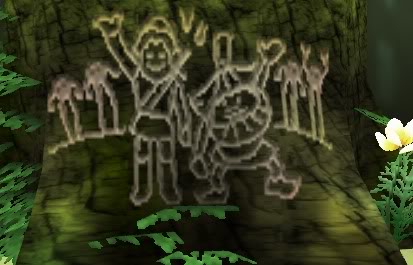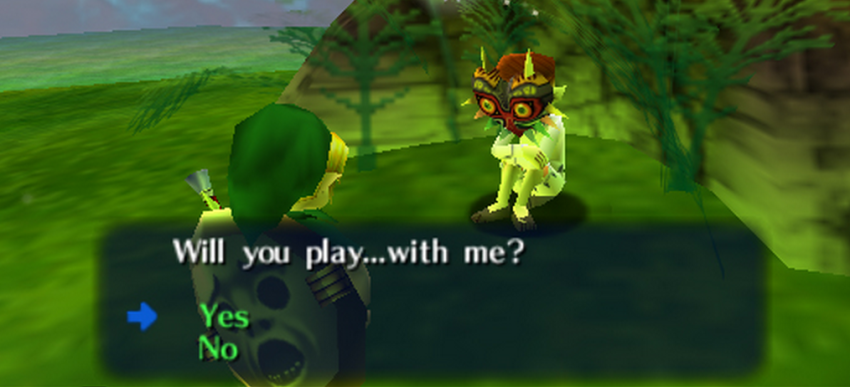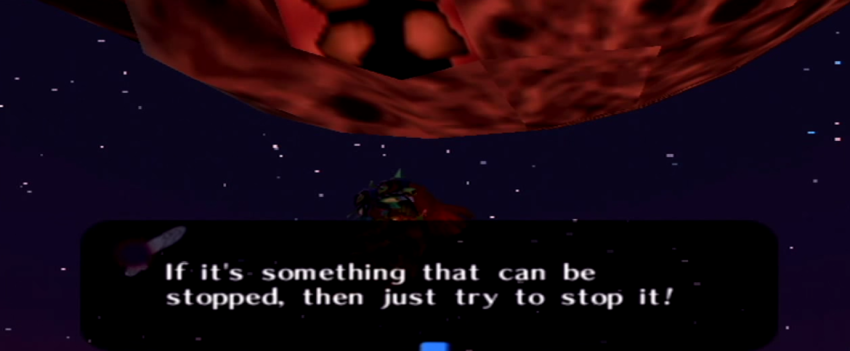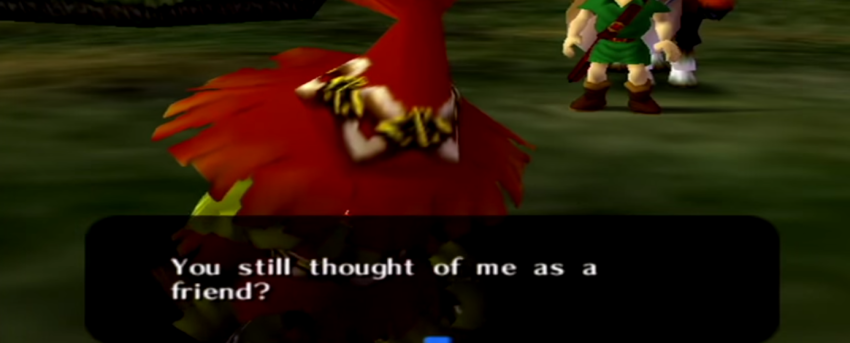“He was Lonely”: the Pathos of Skull Kid
Posted on February 21 2015 by Aaron Suduiko

Today on With a Terrible Fate, I offer an analysis of Skull Kid’s significance, in Termina and beyond.
Throughout the course of “Majora’s Mask,” there are suggestions that Skull Kid deserves forgiveness. When the fourth giant is liberated by Link in Stone Tower Temple, the giant tells Link and Tatl to “forgive [their] friend”; when Skull Kid is ultimately stopped, his fairy, Tael, tells Tatl (Tael’s sister) to not be “hard on the Skull Kid” because “he was lonely” and overcome by the power of Majora’s Mask. Yet it is Skull Kid who leads Link into Termina, and who threatens Termina over its entire three-day cycle by pulling down the moon. I previously analyzed Skull Kid peripherally in my discussion of why he cannot be healed with the Song of Healing; in this edition of With a Terrible Fate, I broaden the scope to analyze what makes the Skull Kid who he is. I approach this treatment by attempting to resolve the problem of Skull Kid’s pathos: ought we to forgive the child who aims to destroy the world?
I haven’t yet talked about themes of subversion, but Skull Kid, like “Majora” more generally, is rife with subversive elements. Skull Kid is the arch-villain without an agenda, a nexus of destruction that is at the same time no more than a child. Like the ethical domain of the game, we want to be able to pin evilness on the chaotic Skull Kid, yet he seems at every juncture to defy this classification. In the game, Skull Kid assumes the role of an absent villain: one who, in spite of architecting the major conflict of the plot, is predominantly absent from the narrative until its ultimate climax. This structure itself is fairly standard both within and without the field of video games — think Sephiroth from “Final Fantasy VII,” Smaug from The Hobbit, etc. — but Skull Kid is unlike many of the other arch-villains who wait at the end of quests. Not only is Skull Kid the locus of conflict for the narrative, but he also causes the narrative in a nontrivial way by leading Link in chase into the perpetually-ending world of Termina — in this way, Skull Kid is the reason why Link is trapped in a world whose persistence is dependent on Skull Kid being stopped.

This last point is important because it allows us to understand Link’s quest as a game on another level. From the beginning of this this series, I have described the morality of Termina as something put on as a game, as in the final confrontation between Majora’s Forms and the Fierce Deity; more recently, I have described the metaphysics of “Majora’s Mask” as ontologically reflecting the essence of video games’ aesthetic dependency on player agency. But now a different form of play is afoot: Skull Kid’s introduction of Link to the universe in which Skull Kid must be stopped can be understood as an invitation to play. Just as Majora the Child invites Link to play “good guys against bad guys” on the moon, the Skull Kid pits Link against him on a universal level by leading him to Termina. In this way, the plot of the game is itself a game. This may seem trivial, yet it is difficult for me to conceive of Final Fantasy VII as a world in which Sephiroth uses Meteor to get Cloud to play with him.
The explanation of Skull Kid’s plot as a game he is playing with Link conforms to the model of Skull Kid’s perceived-evil being reducible to loneliness: games impose the rules of play upon their participants, thereby creating a systematic relationship between the players. Such a system eliminates the potential for isolation, and is therefore an ideal remedy for loneliness. Just as Skull Kid and Majora’s Mask sealed the four giants away while at the same time seeking their friendship (see for evidence: the giants’ desire for Link to forgive Skull Kid; the giants reconciling with Skull Kid after Majora’s defeat; and the presence of the four children symbolizing the sealed giants playing on the moon around Majora the Child), so too has Skull Kid sealed Link within Termina in order to engage in play with him.
Skull Kid at play also explains the endgame of “Majora”: whereas Ganondorf is sealed away in isolation at the end of “Ocarina of Time,” the final image of “Majora” is a drawing of Skull Kid, Link, Tael, Tatl, and the four giants, together as friends. As Skull Kid ultimately says, “friends are a nice thing to have,” and the game concludes with his loneliness ending. Of course, this means we have to bite the bullet and accept that on this interpretation, Skull Kid actually “wins” in the end: by getting Link to play through his game, he ends up making friends. So, in spite of losing the game he set up, his goal is achieved.

We might take issue with an understanding of the game in which Skull Kid wins, and not only because of Termina’s artifice of morality. Within the scope of the game, we might ask exactly why the Happy Mask Salesman must impose morality in order to prompt the player and Link to participate in Skull Kid’s game. This also invites discussion outside the scope of the game: can we assign moral culpability to children, and, if so, how are we to go about it? The game asks difficult questions, but I think it also gives us the theoretical equipment to answer these questions. I close by beginning to derive such answers.
First, consider morality within the scope of the game. When I analyzed the Happy Mask Salesman, I described the moral imposition as motivational force hearkening back to “Ocarina of Time”; I think this line of reasoning is also useful in the current case. How do you convince a player who has walked into a game assuming the role of a hero (Link) to undertake a game lacking the moral grounding with which to adequately define heroism? Convince the player that the game is, in fact, a heroic quest. Only later is it implied that the quest is morally groundless, as the play element is explicated in Majora the Child’s invitation to play good guys against bad guys. This is actually another instance of subversion: it is oftentimes the case that in playing games, we encounter moral structures (e.g., the good-and-evil of “Ocarina of Time”); yet in this case, Link engages a moral structure only to uncover that it is a game. Subversion is useful for Skull Kid in this way because Skull Kid is trying to subvert his own self concept by making friends: like the Song of Healing functioning as a transitional device between solitude and community, Skull Kid is seeking to transform his loneliness, something which is fundamental to his worldview. Thus, Skull Kid, in his childhood state of mind, subverts the entire world around him in order to subvert his worldview. This subversion is what draws both the player and Link in, and is what allows Skull Kid to “win.”
What about the moral question beyond the game, of morality with respect to childhood innocence? Recall from my account of why Skull Kid cannot be healed that I described Skull Kid as ‘possessed’ by the moral valence of Majora, which is incoherent with the metaphysics of Termina. We can reframe this account in terms of actions and intentions: that is to say, there is a difference between the amoral desire of Skull Kid to not be alone (in our reframing, ‘intention’), and the moralized instrument of Majora and the power of the Mask (‘actions’). I think this account demonstrates that it is useful to analyze and treat agents independently of the moral ramifications of their actions. The reasoning is this: playing a game with Skull Kid, instead of treating him as evil and extinguishing him, allows Link to become Skull Kid’s friend and effectively “heal” him without implementing the Song of Healing. In a way similar to how the lack of Zelda allows a more human tapestry of princesses to emerge, the amoral level of discourse in the game is what allows Link to stop Skull Kid by befriending him, in a way that he would never be able to befriend Ganondorf, the Great King of Evil. So a secondary moral thesis emerging from the metaethical thesis of “Majora’s Mask” could be stated as follows: ‘it is pragmatic to analyze and address agents prior to moral analysis of the actions taken by said agents’.

The pathos of Skull Kid is that in spite of driving the entire plot of “Majora’s Mask” and constantly threatening the world’s existence, he never has to be seen as a villain — and, indeed, the salvation of both him and the world depends upon seeing him as a friend instead of a villain. This is the crux of the game he plays: it is not only an internally consistent instance of play, but it is a paradigm with which we can view the moralized structures of other narratives beyond the moral lens. Perhaps Link could never befriend Ganondorf, but we may be able to understand even the most moral of conflicts better by viewing them as games prior to ethics.
Want to follow the analysis and theory? Read on at With a Terrible Fate.
Aaron Suduiko, Phillips Exeter Academy ’13, Harvard University ’17. Studies philosophy with a focus on developing new aesthetic theory with a grounding in the medium of video games. In 2013, he conducted a comparative analysis of role playing paradigms in video games (“Legend of Zelda: Majora’s Mask,” “Nier,” “Dishonored,” and “Deus Ex: Human Revolution”) and plays (“Six Characters in Search of an Author,” “The Man in the Iron Mask,” “Macbeth,” and “Flowers for Algernon.” He is the author of “With a Terrible Fate,”a twice-weekly analysis of “Majora’s Mask” that is published by Zelda Dungeon and is set to continue through the release of the 3D remake this coming spring. Suduiko is reachable at withaterriblefate@gmail.com.



